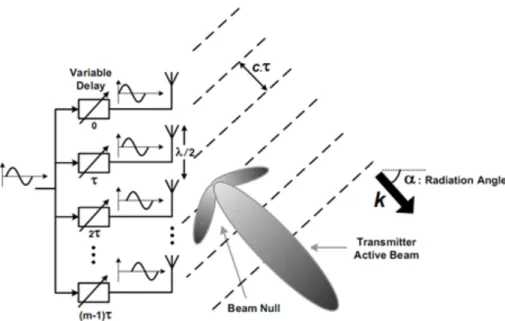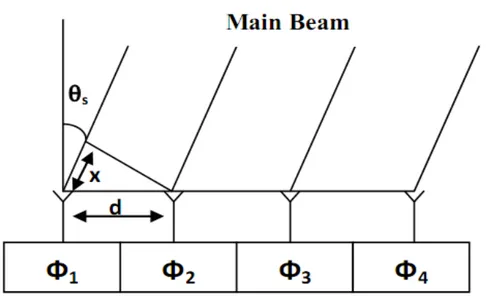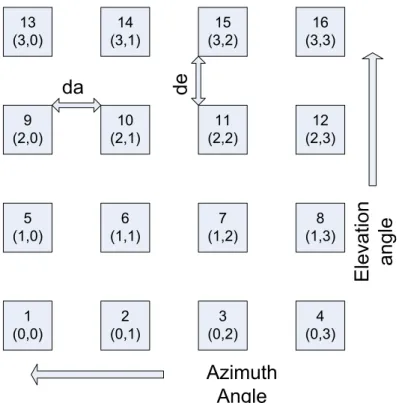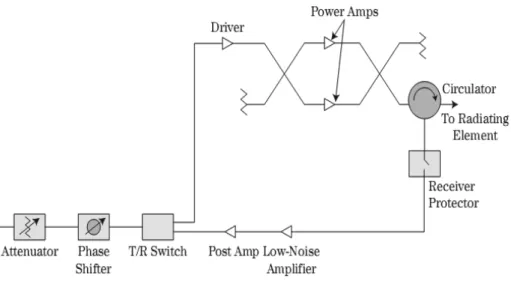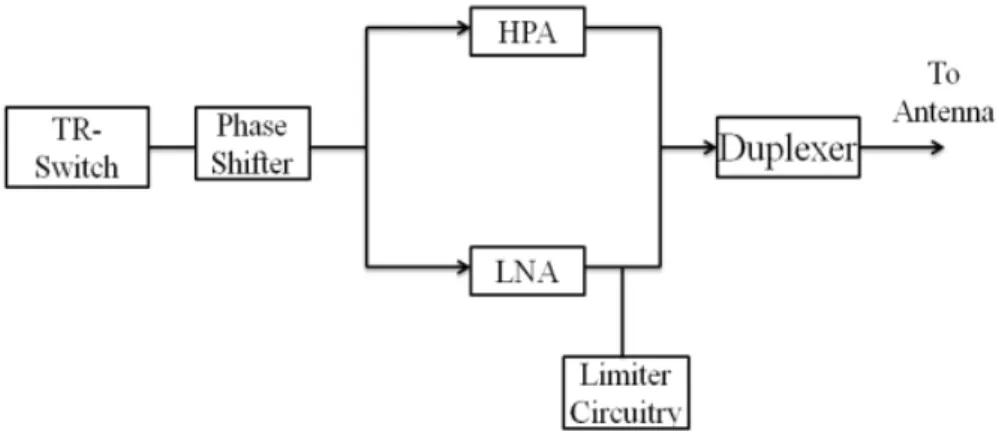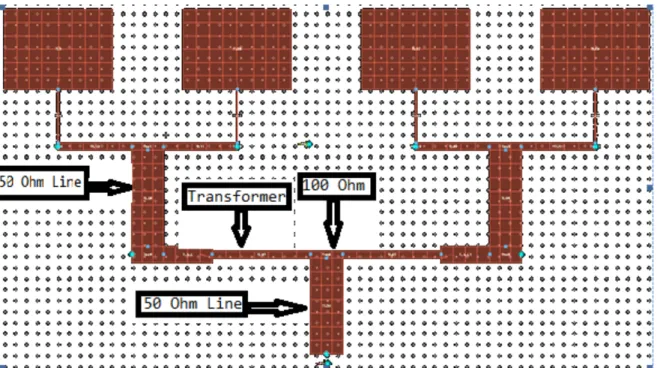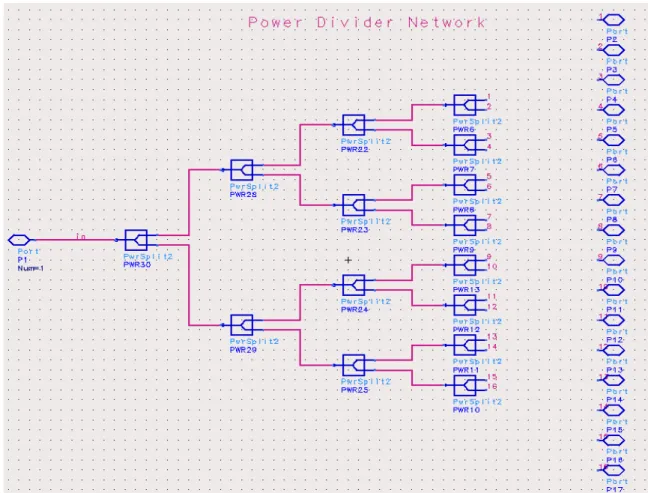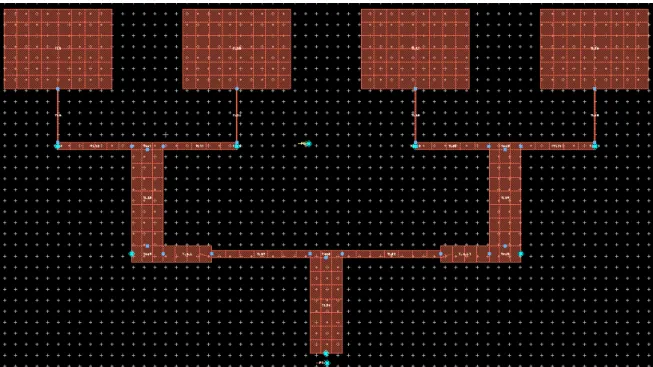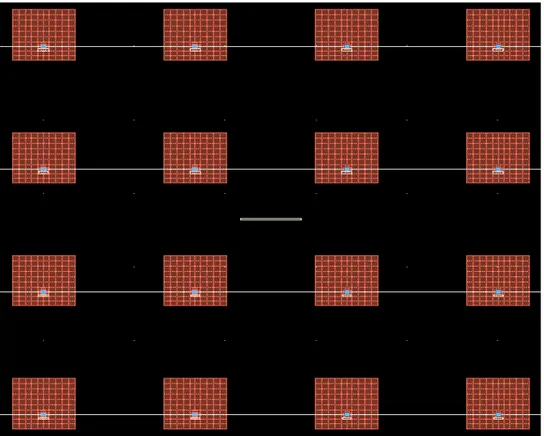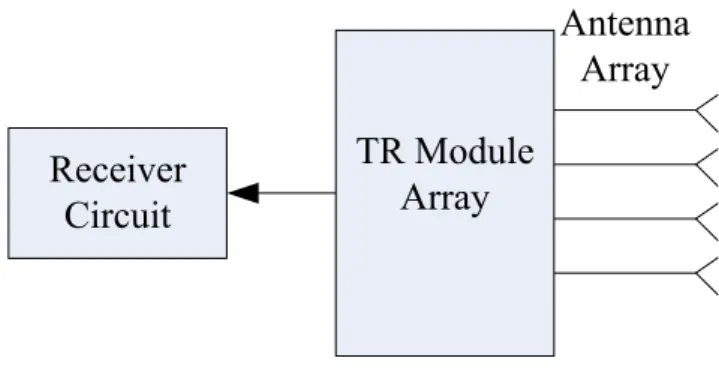!
Design and simulation of beam steering for 1D and 2D phased
antenna arrays using ADS
Degree Project
Authors: Muhammad Zeeshan Afridi, Daniyal Razi and Muhammad Umer Date: 2012-‐06-‐18
Subject: Master Thesis
Supervisor: Prof. Sven-‐Erik Sandström
Department of Computer Science, Physics and Mathematics
Submitted for the degree of Master in Electrical Engineering
Specialization in Signal Processing and Wave Propagation
Acknowledgement
We would like to express our sincere gratitude to our supervisor Dr. Sven-‐Erik Sandström for his continuous support, invaluable assistance and guidance during the entire period and in making this work possible. Deepest gratitude is also due to the Department of Computer Science, Physics and Mathematics, Linnaeus University, for providing the best educational facilities. We would also like to thank our seniors, fellow friends and siblings for their support and encouragement.
Last but not least, we would also wish to express our love and gratitude to our beloved families; for their support and understanding throughout our lives.
Abstract
Phased arrays eliminate the problems of mechanical steering by using fast and reliable electronic components for steering the main beam. Modeling and simulation of beam steering for 1D and 2D arrays is the aspect that is considered in this thesis. A 1D array with 4 elements and a 2D array with 16 elements are studied in the X-‐band (8-‐12 GHz). The RF front-‐end of a phased array radar is modeled by means of ADS Momentum (Advanced design system).
Keywords: Phased array, Patch antenna, RF front-‐end, Beam steering, ADS Momentum.
Table of Contents
Chapter one: Introduction__________________________________________________________ 6 1. Introduction_________________________________________________________________ 9
1.1. Background_____________________________________________________________ 9 1.2. Thesis motivation _________________________________________________________ 9 1.3. Thesis objective __________________________________________________________ 9 1.4. Thesis overview _________________________________________________________ 10 Chapter two: Literature review______________________________________________________11
2.1. Antennas_________________________________________________________________ 11
2.2. Antenna types __________________________________________________________ 12 2.3. The microstrip patch antenna ______________________________________________ 12 2.4. Shapes of patch antennas _________________________________________________ 13 2.4.1. Substrate for the patch antennas _______________________________________ 14
2.5. Antenna arrays __________________________________________________________ 14
2.6. The Phased array ________________________________________________________ 14 2.6.1. Principle of the phased array _____________________________________________ 15 2.6.2. The passive phased array ________________________________________________ 16 2.6.3. The active phased array _________________________________________________ 16 2.6.4. Array configuration ____________________________________________________ 17 2.6.5. Array size ____________________________________________________________ 17 2.6.6. Active input impedance _________________________________________________ 17 2.6.7. Spacing between adjacent elements _______________________________________ 18 2.6.8. Beam steering ________________________________________________________ 18
2.7. Radar____________________________________________________________________20
2.7.1. The radar equation ____________________________________________________ 20 2.7.2. Radar cross section ____________________________________________________ 20 2.7.3. The TR module ________________________________________________________ 21 2.7.4. Literature about the TR module __________________________________________ 22 2.8. System modeling and specification __________________________________________ 23
2.9. Target modeling _________________________________________________________ 23
Chapter three: System design and modeling___________________________________________ 24 3.1. Antenna design _________________________________________________________ 24 3.1.1. The design process ___________________________________________________ 24 3.1.2. Design specification __________________________________________________ 24 3.1.3. Design parameters ___________________________________________________ 24 3.1.4. Mathematical model of the patch antenna _______________________________ 25 3.1.5. Designing of a rectangular patch antenna _________________________________ 27 3.1.6. The Antenna array ___________________________________________________ 28 3.2. Complete system model __________________________________________________ 29
3.2.1. The RF pulse transmitter_______________________________________________29 3.2.2. The RF power divider network__________________________________________29 3.2.3. System level modeling of the TR module__________________________________30 3.3. 1D antenna array design___________________________________________________31 3.4. 2D antenna array design___________________________________________________32 3.5. Radar front end modeling__________________________________________________34
3.5.1. Signal analysis_______________________________________________________35
Chapter four: Simulation results and analysis__________________________________________ 37 4.1. The single element side feed patch antenna __________________________________ 37
4.1.1. Radiation pattern and gain ____________________________________________ 38 4.1.2. 3D radiation pattern _________________________________________________ 39 4.2. Simulation of a 1D phased array antenna _____________________________________ 40 4.2.1. Radiation pattern and gain ____________________________________________ 40 4.2.2. 3D radiation pattern _________________________________________________ 41 4.3. Simulation of a 2D phased array antenna _____________________________________ 42 4.3.1. Directivity and gain __________________________________________________ 43 4.3.2. S!! parameters _____________________________________________________ 44 4.3.3. Efficiency and radiated power __________________________________________ 45 4.3.4. 3D Radiation pattern _________________________________________________ 46 4.4. Simulation of beam steering of a linear array __________________________________ 47 4.5. Simulation of beam steering of a 2D array ____________________________________ 48 4.6. The RF front end ________________________________________________________ 49 Chapter five: Conclusion___________________________________________________________51
5.1. Conclusion _____________________________________________________________ 51 5.2. Future work ____________________________________________________________ 51 References______________________________________________________________________52
Table of Figures
Figure 2.1: Shapes of patch antennas ... 13
Figure 2.2: The phased array transmitter ... 15
Figure 2.3: Block diagram of a passive phased array ... 16
Figure 2.4: Block diagram of an active phased array ... 17
Figure 2.5: Beam steering ... 18
Figure 2.6: 2D antenna array arrangements ... 19
Figure 2.7: Block diagram of a typical TR module. ... 21
Figure 2.8: Common phase shifter configuration of a TR module. ... 21
Figure 2.9: Seperate phase shifter configuration of a TR module. ... 22
Figure 3.1: Patch and Ground plane. ... 22
Figure 3.2: Top view of rectangular patch antenna. ... 26
Figure 3.3: Series feed. ... 26
Figure 3.4: Corporate feed. ... 29
Figure 3.5: An antenna array using corporate feed layout designed in ADS Momentum. ... 29
Figure 3.6: The Wilkinson power divider network 1:16 schematic designed in ADS Momentum. .... 30
Figure 3.7: Radar TR module schematic designed in ADS Momentum. ... 31
Figure 3.8: 1D Antenna array schematic designed in ADS Momentum. ... 32
Figure 3.9: 1D Antenna array layout designed in ADS Momentum. ... 33
Figure 3.10: 2D Antenna array designed in ADS Momentum. ... 33
Figure 3.11: 2D Square patch antenna array designed in ADS Momentum. ... 34
Figure 3.12: System level model of an active phased array radar system. ... 34
Figure 3.13: The Switching signal ... 35
Figure 4.1: Single element side-‐feed patch antenna designed . ... 37
Figure 4.2: S11-‐parameter of single side-‐feed patch antenna in ... 38
Figure 4.3: Radiation pattern of single side-‐feed patch antenna . ... 38
Figure 4.4: Gain of the single side-‐feed patch antenna . ... 39
Figure 4.5: A 3D graph of the far field radiation of a single square patch Antenna ... 39
Figure 4.6: ID Phased array patch antenna designed . ... 40
Figure 4.7: Radiation pattern of a 1D phased array antenna . ... 40
Figure 4.8: Gain of a 1D phased array antenna . ... 41
Figure 4.9: Excitation of 1D phased array antenna obtained with ADS . ... 41
Figure 4.10: Top view of a 1D phased array antenna ... 42
Figure 4.11: Three dimensional view of a 2D phased array patch antenna . ... 42
Figure 4.12: Gain and directivity of a 2D phased array patch antenna in ... 43
Figure 4.13: The magnitude vs frequency graph of S!! . ... 43
Figure 4.14: The corresponding phase of S!! . ... 44
Figure 4.15: S11 plotted on a smith chart for frequency band 8-‐12 GHz. ... 44
Figure 4.16: Efficiency of the 2D phased array patch antenna . ... 45
Figure 4.17: Radiated power of the 2D phased array patch antenna . ... 45
Figure 4.18: 3D Directivity pattern of the 2D phased array antenna ...46
Figure 4.19: Functional block diagram of beam steering. ... 46
Figure 4.20: Simulation of a Linear array beam steering in. ... 47
Figure 4.22: Transmitted pulse, time domain. ... 48
Figure 4.23: The amplitude of the transmitted pulse in frequency domain ... 49
Figure 4.24: Reflected signal, time domain. ... 49
List of Tables
Table 3.1: Parameters of the desired antenna...27
Table 3.1: Dimensions of the rectangular patch...27
Table 3.2: Dimensions of the quarter wave transformer...27
Table 3.3: Dimensions of the feed line...27
Table 4.1: Relative phase of the elements in degrees...48
Chapter one: Introduction
1. Introduction
This chapter gives a brief introduction to the thesis along with the objectives and the motivation behind this thesis.
1.1. Background
Radar is an acronym for Radio Detection and Ranging. It refers to a device which uses a radio frequency signal for the detection and ranging of targets. The principle is to measure the time delay between the transmitted and received RF pulse and through analysis determine the range and speed of the target. The radar antenna is used to focus energy in the direction of interest. A key issue in the design of an antenna is its side lobes. Side lobes are extremely harmful to the radar system as it is difficult to separate main lobe from side lobe reflections. Another disadvantage with the side lobes is that they make it easy for a jamming system to detect the radar. In order to solve the side lobe problem, various complex antenna designs were proposed. Via the intermediate step of fixed arrays this led to the present phased arrays.
Phased arrays are based on the principle that a consistent phase shift (time delay) in the signals that are feed to the antenna elements can be used to steer the main lobe in the desired direction. Phased array radars did not become airborne until the late eighties and was mainly used for ground based applications because of the substantial volume of the hardware involved. The obvious benefits of the phased array and continuous research has made it possible to develop phased arrays based on monolithic microwave integrated circuits (MMIC’s) [1].
1.2. Thesis motivation
Considering the importance and the numerous applications of phased array technology, in defence, medical and other commercial applications like mobile and satellite communication, this thesis focuses on the system level modelling and simulation of the front-‐end of the phased array radar. The phased array has numerous applications as it is energy-‐efficient and agile as compared to traditional technologies. This technology is mostly used for defence purposes but considering its potential, one can safely assume that it will be adopted in many other applications in the future.
1.3. Thesis objective
The objective is to design and simulate antenna elements at system level with the emphasis on the front end of the radar without going into the details of signal processing. It is desired to develop a model of the phased array radar that can verify basic concepts of the radar front end.Specifically, one wants to simulate antenna elements at the targeted frequency by means of advanced design software. Arrays in 1D (4x1) and 2D (4x4) are also simulated.
1.4. Thesis overview
Chapter 1: Brief introduction to phased array technology.
Chapter 2: It gives a summary of the literature reviewed during the research work. The process of designing a patch antenna, an antenna array and beam steering is described. A brief overview of the TR module, the RF front end and the complete system model is given.
Chapter 3: This chapter deals with the actual modeling of the system. Designing the patch antennas at the targeted frequency (x-‐band), modeling of the TR module and the RF front end of the phased array radar.
Chapter 4: This chapter presents the simulation results, which includes results from the designed antennas, simulation of beam steering both for the 1-‐D (1x4) and 2-‐D (4x4) array and the results for the RF front end using a pulsed RF signal.
Chapter 5: This chapter concludes and identifies directions for an extension of this work.
Chapter two: Literature review
2.1. Antennas
An antenna is a device which transmits and receives electromagnetic energy. The energy, in the form of waves with combined electric and magnetic fields is propagating in space. In order to have a successful communication, two antennas, an antenna to transmit and an antenna to receive, are needed. At the transmission side, the electric energy (current and voltage) is converted into electromagnetic energy and at the receiver side the electromagnetic energy is converted back into electric energy. In order to transmit efficiently, the physical size of the antenna must be at least one-‐tenth of the wavelength. It is the operating frequency rather than the bandwidth that determines the size even though they are linked [2].
Antennas fall into two categories based on the radiation pattern: omnidirectional and directional. In principle the omnidirectional antenna exists only in textbooks since the dipole is the simplest electromagnetic source. A directional antenna focuses energy in a certain direction. An antenna system provides the following functionality.
• Concentrates energy in the direction of the target. • Collects the echoes reflected by the target.
• Estimates the angle of arrival (azimuth and elevation) from the received echo signal. • Determines the range (distance) to the target.
• Acts as a spatial filter and resolves its scan area into angles. It receives signal only in the direction of the main lobe and rejects signals coming from the other directions [3].
Important antenna parameters are gain, directivity, input reflection coefficient. The directivity is an important parameter of an antenna and for radar applications the antenna needs to be very directive. The efficiency of an antenna is also a prominent figure-‐of-‐merit for the overall effectiveness of the system. Antennas have gone through great advancements due to the continuous research efforts on bandwidth, efficiency, gain and size. Many compact and light weight antennas are being developed for airborne applications.
In a phased array radar, it is not the single element’s radiation pattern that is essential but rather the radiation pattern of the whole array. The directivity of an array depends on the number of elements as well as the arrangement of the elements [4].
2.2. Antenna types
Parabolic reflectors are mostly used in mechanical steered antenna systems. The reflector dish reflects the field from a source at the focal point. A point source generates EM waves, which are then directed by the reflector. Similarly, during reception, the reflector collects and directs energy to its focal point. Parabolic reflectors can have large apertures, which allows the system to receive more energy. Similarly, it can concentrate energy in a very narrow beam during transmission and thus have large gain.
The broadside array is another type of antenna that is used in many radar systems. It has a number of radiating elements, placed a half wave length apart, with a flat reflector behind the elements. The radiation is essentially perpendicular to the array and the reflector directs energy in the desired direction.
Microstrip patch antennas are also used for radar applications. High directivities can be achieved since they are easy to fabricate. The number of patches in an antennas in an array can reach one thousand.
2.3. The microstrip patch antenna
The basic parameters of a microstrip antenna are covered in this part of the chapter. Step by step, the design process of the microstrip antenna is also explained.
In the quest for lightweight and compact antennas the microstrip antenna was a significant development. Microstrip patch antennas are, due to their size, weight, ease of manufacture and installation, very useful in medical, industrial and military applications. Unlike other types of antennas, prototypes can easily be manufactured.
Patch antennas have certain disadvantages; they have low power handling capability, a very wide beam and their bandwidth is also very narrow. In severe jamming situations, wideband antennas are very useful to reduce the jamming effect on radar and for this reason the antenna needs wideband impedance matching. Patch antennas are also developed for phased array applications. Space based radar systems have additional requirements on mechanical and thermal properties. 2D antenna arrays can be further divided into sub arrays for handling purposes. To achieve the required bandwidth, the dual stacked patch technique was used in combination with the probe feed technique. It was found that the beam steering in the azimuth plane with horizontal polarization was limited to 30 degrees with a return loss of 10 dB. When the scanning area was increased to 45 degrees the return loss dropped to 7 dB [2, 4].
2.4. Shapes of patch antennas
Some of the very common shapes of the patch antennas are shown in Figure 2.1.
(a) Square (b) Rectangular (c) Elliptical (d) Triangular
(e) Circular Ring (f) Ring Sector (g) Circle (h) Dipole Figure 2.1: Shapes of patch antennas.
The most common shapes are circular and rectangular patches. These two shapes are favoured because of their mathematical models and radiation characteristic; hence they are easiy described and therefore used in this work. Their equivalent mathematical models can be found in various forms in the literature [2]. Along with the shape, the type of substrate is essential for the patch.
2.4.1.
Substrate for the patch antennas
An important constituent in the design of a patch antenna is the substrate. There are two common substrate materials available in the market, FR-‐4 and Roger duroid.
The FR-‐4 is a cheap substrate material, and it is also easily available in the market. The problem with this material when compared with the Rogers is that it has a very high loss tangent. Its loss tangent also changes with the frequency; higher frequency generally leads to more losses in FR-‐4. This property of the FR-‐4 explains some of the differences between the measured and the simulated results. Therefore, FR-‐4 is not preferred when accuracy is essential. Roger duroid, on the other hand, has all the benefits which FR-‐4 lacks, but it is a very expensive material. In this thesis FR-‐4 is used due to its availability and price [5].
2.5. Antenna arrays
The antenna array is based on the principle that when antenna elements are arranged in an array, the directivity of the radiation pattern increases. Initially, antenna arrays were used to increase the directivity and gain of the resulting beam of energy, but it was later found that beam steering can also be managed by a delay at each antenna element. The number of antenna elements and their arrangement are important for the directivity and the beam steering capability of the radar. As a general rule, the directivity of the array increases with the number of elements since the total aperture gets larger.
Depending on the scan area, antennas can be arranged on 2D surfaces such as spheres and cylinders. These arrays have their own issues like impedance matching with a varying scan angle and mutual coupling between the antenna elements. Ring arrays have a less directed radiation pattern and large grating lobes [4].
2.6. The Phased array
The phased array has the capability of varying the phase or introducing time delay at each antenna element in order to steer the main lobe. Despite all the efforts and development in this area, the phased array is still a very expensive technology. Researchers are making efforts to reduce the price by using cost effective components in order to make it viable commercially. Ultrasonic phased arrays are used to detect faults in mechanical structures without deforming the material [6].
A phased array has certain limitations; one of its shortcomings is the practical scan angle. Typically, the scan angle of the phased array is between 45 and 60 degrees. There are two factors responsible for this limitation; one is the effective length of the antenna. The effective length of the array decreases with the increasing scan angle and it becomes zero at an angle of 90° according to Eq. (2.6.1).
!′= !"#$(!)
(2.6.1)
L’ is the effective length of the array, L is the actual length and θ is the scan angle.
2.6.1. Principle of the phased array
A phased array is composed of a number of radiating elements, each with a phase shifter. Deflection of the main beam can be achieved by introducing a phase difference between the elements. The electronic steering capability offers control of the directivity and gain. This eliminates the the need for mechanical rotation [7].
In the phased array transmitter/receiver configuration the beam is focused to the direction of interest. Possible interference from any other direction can be avoided by creating a null in that direction, thus providing a capability for avoiding interference.
Transmission and reception are linked by the reciprocity theorem. Figure 2.2 shows m transmitters having a delay element in each line. When an input signal !(!) is fed to each element, the signal is delayed by the multiple of ! and the resulting signal is given by Eq. (2.6.2),
!! = S(t − kτ − n − 1 − k d sin θ c ) !!! !!!
(2.6.2)
Therefore, signals from the elements add coherently in a desired direction ! = sin!! !"
! , while in other directions they essentially cancel. d is the spacing between the elements and c is the speed of light. It is the coherent addition that increases the radiated power in the desired direction.
At reception, the signal arrives at different points in time to the antenna elements and the time difference is then used to find the direction of arrival. The direction of arrival estimation is a highly active research field both for radar and telecommunication.
2.6.2. The passive phased array
An array with only one transmitter and receiver is referred to as passive. The beam steering is done with phase shifters at the antenna elements as shown in Figure 2.3.
Figure 2.3: Block diagram of a passive phased array.
The passive array has a high power amplifier (PA) in the transmit path and a low noise amplifier (LNA) in the receive path. This design is less reliable and requires high power handling capability in the transmit path. These shortcomings are eliminated in the active phased array [8].
2.6.3. The active phased array
The active array has a T/R module for each antenna element. The T/R module consists of a transmitter, receiver, phase shifter, TR switch and duplexer.
The system will not shut down, if one of the TR module stops working. Since the phase shifter precedes the transmitter the power is low. Another main advantage of the active phased array is the multiple beam handling capability. Since the elements are fed independently one may have multiple beams operating at multiple frequencies. The receiver is placed close to the antenna to reduce losses.
Figure 2.4: Block diagram of an active phased array.
2.6.4. Array configuration
The array configuration is the geometrical arrangement of elements in an array. The simplest configuration has elements in a rectangular or quadratic planar grid. Another configuration described in the literature is the circular array. The structure looks like a big circular antenna. This type of antenna can be found in the front of jet planes.
2.6.5. Array size
The array size determines the directivity, since directivity increases with the number of elements. The number of elements in an array may vary from a few to a thousand depending on the application. In defence radars, the numbers of elements is extremely large [9].
2.6.6. Active Input Impedance
The active input impedance is one of the factors that limit the usefulness of the phased arrays. It comes into action when the array is scanning at large angles and it is due to induction from other radiating elements. The voltage source that feeds an element is not the only source acting on the element. The surrounding elements couple to the first element and this effect becomes severe as the angle of the beam increases. The coupling depends on the spacing between the elements [9].
2.6.7. Spacing between adjacent elements
The antenna elements are typically half a wave length apart. An increase in the element spacing up to 0.9 λ increases the directivity but it also increases the side lobe levels. The important parameters in array design are element spacing and the number of elements.
2.6.8. Beam steering
The electronic steering has many advantages over mechanical steering: agility, accuracy, flexibility. It can be used to track targets maneuvering at greater speeds due to the flexible electronic control of the main beam. Since there is no physical movement of the structure, the system is less prone to wear and tear and is more durable than the mechanical systems.
The principle of beam steering can be easily understood with the help of Figure 2.5. Steering can be achieved by means of a phase difference between radiating elements. In Figure 2.5, four elements are arranged in linear array, with the spacing d between adjacent elements [9]. With this arrangement, the Nth element has a delay of (N-‐1)(Ф).
x=d sin!!
(2.6.3)
Figure 2.5: Beam steering.
The phase difference Ф corresponds to a path difference x between the two adjacent beams. The ratio of the path difference x to the wavelength λ should be equal to the ratio of the phase difference Ф to 2π (3600), because 2π is the angle corresponding to one wavelength.
!!
Ф
=
!
!
(2.6.2)
Using Eqs. (2.6.3) and (2.6.2) the angle Ф is then given by,
∅ =
2!" sin !
!!
(2.6.3)
where d is the element spacing and !! is the desired angle of steering.
The complexity of beam steering increases if a 2D array is considered. In 2D, the beam can be steered in two directions. A 4x4 array is shown in Figure 2.6 .
Figure 2.6: 2D antenna array arrangements.
The elements are arranged in a matrix of rows and columns as indicated by the numbers. The first element (0, 0) is used as a phase reference. The direction of the beam is specified in polar coordinates (θ ,Ф).
The relative phase difference between the antenna elements in 1D and 2D arrays are given by Eq. (2.6.3) and (2.6.5), respectively.
!!
!,!= ![!!
!sin ! + !!
!sin !] (2.6.5)
Here k= 2!!, and r and c is the row and column number of the element, respectively. dr is the
distance between the elements in a row and dc is the distance between the elements in a column.
The azimuth angle to be steered is Ф and the elevation steering angle is θ.
13 (3,0) (3,1)14 (3,2)15 (3,3)16 9 (2,0) (2,1)10 (2,2)11 (2,3)12 5 (1,0) (1,1)6 (1,2)7 (1,3)8 1 (0,0) (0,1)2 (0,2)3 (0,3)4
E
le
va
tio
n
an
gl
e
Azimuth
Angle
de
da
2.7. Radar
A radar has a transmitter that radiates electromagnetic waves toward a target. In the case of a monostatic radar the target reflects the waves back to the receiver. In the bistatic case the waves are received by a receiver that is not located at the transmitter. The strength of the reflections from the target depends on the size, shape and electrical conductivity of the target. The basic idea of radar dates back to the late 19th century, but the principal development of radar technology did not occur until World War II. Today, radar is used extensively in a number of civilian applications, e.g. air-‐traffic control, remote sensing of the environment, aircraft and ship navigation, space surveillance and planetary observation [3].
2.7.1. The radar equation
The radar equation relates the transmitted and received power to the range of the radar. The received power
!
!is given by,
!
!=
!
!!
!! !
(4!)
!!
!
(2.7.1)
Pt is the transmitted power, G is the gain, !! is the effective aperture of the receiving antenna,
given by the physical area and the aperture efficiency, ! denotes the radar cross section and differs from the physical area of the target.
Equation (2.7.1) can be used to estimate the maximum range of a radar. Every system has a certain sensitivity floor below which the system cannot differentiate the signal and the noise. Since the signal level decreases with range, there is limit where the receiver can no longer detect the target. The maximum range of a radar is given by,
!
!"#= [
!! !! !"!! ! !!
]
!
!
(2.7.2)
This is the fundamental radar equation and gives the maximum range in terms of the parameters of the radar and the target.
2.7.2. Radar cross section
The radar cross section is denoted by
σ and describes the
scattering properties of the target. It represents the physical size of the target as seen by the radar and has the dimensions of square meters. The RCS area is a measure of a target’s ability to reflect radar signals in the direction of the receiving antenna [2]. In general, the RCS is a function of the polarization of the incident wave, the angle of incidence, the angle of observation, the geometry of the target, the electrical properties of the target and the frequency of operation [10].
2.7.3. The TR module
The TR module is an integral part of the phased array radar. A typical configuration is shown in Figure 2.7.
Figure 2.7: Block diagram of a typical TR module.
The essential components are:
Attenuator: The attenuator in a TR module adjusts the gain of the system to minimize the side lobes as well as to steer the nulls in the direction of interfering sources.
Phase Shifter: The phase shifter provides the required phase shift to steer the antenna beam. TR Switch: The transmit/receive or TR switch controls the operation of the module. In most cases, it is a single pole double throw (SPDT) switch, that switches the system between the transmit and receive modes.
Power Amplifier: These gain blocks amplify the transmitted signal. The amplification depends upon the type of function and range of the radar.
Circulator: It is a passive device that connects the antenna to the transmit section and isolates the sensitive receive circuitry from the high transmit power.
Limiter Circuitry: This protection circuit is incorporated mainly to protect the low-‐noise amplifier from being saturated by high transmit power reflected backward due to the antenna mismatch. It also prevents the high power jamming signals from damaging the system.
Low Noise and Post Amplifier: The received signals are often weak and noisy. To extract meaningful information, the signal is amplified by a low-‐noise amplifier (LNA), to minimize the noise injected by the system [11].
2.7.4. Literature about the TR module
There are different types of TR modules described in literature, in this case matters relating to phased array radars. The electrical design has two standard configurations, the common and the separated architecture [12]. In the common architecture, there is a single phase shifter that is being shared by the transmitter and receiver while the separate architecture has two phase shifters. The common and separate topologies are shown in Figures 2.8 and 2.9, respectively.
Figure 2.8: Common phase shifter configuration of a TR module.
Figure 2.9: Seperate phase shifter configuration of a TR module.
A hybrid mechanical/electrical systems can also be used. Azimuth scanning is performed by mechanical rotation while elevation scanning is done by means of electronic beam steering [12].
2.8. System modeling and specification
In any modeling, the first thing is to search for specifications of related systems in the literature. Literature was surveyed for specifications of operating phased array radars.
The quest for phased array radars started with a US navy venture in 1958. An extremely advanced system called typhon was developed in order to detect multiple targets. However, the project was later abandoned. A second attempt towards building a phased array was SPG-‐32 and SPG-‐33. Considering the failure of typhon, some of the system requirements were relaxed in SPG-‐32 & 33. The relevant technology was not mature at that time; transistors were not available on a mass scale and vacuum tubes had to be used. Despite all the challenges, the system was built and installed on war ships. The system failed, however, not due to the fundamental design but because of the subsystems and hence SPG-‐32 & 33 were abandoned in the late 70’s.
After the failure of the first two projects, Spy-‐1 was the next attempt to build a phased array radar. Having learned from the first two failed attempts, designers mainly focused on the digital system controlling the beam. A prototype of the antenna was installed on a ship in 1974. Extensive testing of the system was carried out and the results were very impressive. Spy-‐1 operates in the S-‐band and utilizes four passive arrays with dimensions 3.65 m x 3.65 m. The beam width was 1.7 degrees [1, 13].
2.9. Target modeling
Accurate modeling of the target is closely related to the real time environment and is critical for the testing of the modeled system. In the case of radar, the signal strikes the target and returns back to the receiver where it is being analyzed. Theoretically, target reflections can be accurately characterized by the Maxwell equations, but the problem is that the solution of these equations is tractable only for simple target shapes. Therefore, radar designers look for a number of approximation techniques,
1. A scaled down version of the target which reduces the accuracy.
2. Use of a large number of antenna arrays in an anechoic chamber which illuminates the target from various directions [14].
The radar target modeling is a complex task and requires detailed information about the target geometry. Some targets can be visible within a very narrow angle while others are visible throughout. The objective of target modeling is to determine how much of the scattered field that comes back towards the receiver [10].
Chapter three: System design and modeling
3.1. Antenna design
The antenna is an interface between the transmitter and free space. Various antenna designs were considered during the thesis work. Patch antennas were selected for further investigation because of advantages like compact size, light weight and ease of manufacturing. They have a number of medical, industrial and military applications. Unlike other type of antennas, they can easily be built for prototype purposes.
3.1.1. The design process
The efficiency of an antenna is a prominent figure-‐of-‐merit. The antenna efficiency depends on the gain and the reflection coefficient (impedance matching). The port impedance is normally chosen to be 50 Ω. At high frequency, it is desirable to use low loss and high quality substrate materials such as Roger RT Duroid. However, for prototype purposes, FR-‐4 can be used since it is cheap and readily available. The design of a microstrip patch array is divided into four steps: defining specifications, design of a single patch, design of an array and simulation of an array [15]. Patches have many shapes: rectangular, circular and triangular [2].
3.1.2. Design specification
The antenna used in radars needs to be very directive at the desired frequency. A low reflection coefficient is important in the design of the antenna feed.
The four feeding techniques are: microstrip line, coaxial probe, aperture coupling and proximity coupling [2]. The microstrip line is used in this design due to its simplicity.
3.1.3. Design parameters
The side and top view of the single patch along with the related parameters are shown in Figures 3.1 and 3.2, respectively. The substrate with relative permeability ε! is sandwiched between two conducting plates. The upper conducting plate is etched to produce the desired shape, while the lower conducting plate acts as a ground plane.
Figure 3.1: Patch and Ground plane.
h Substrate (εr)
Bottom Copper, Ground Plane Top Copper, Antenna
Copper Layer, Thickness 35µm
Figure 3.2: Top view of rectangular patch antenna.
The resonant frequency of the antenna depends upon the dimensions of the patch and the dielectric [15].
3.1.4. Mathematical model of the patch antenna
The cavity model or the transmission line model are conventionally used in the design of a microstrip patch. The simpler transmission line model is used here.
This model treats the patch antenna as an array of two radiating slots, seperated by a low impedance transmission line of length L [2]. The transmission line method is used to find the parameters of the patch for desired performance [2, 16].
The first step is to find the width
w
of the patch at the desired frequency, using Eq. (3.1.1).
! =
!
2!
!2(!
!+ 1)
(3.1.1)
where !! is the relative permittivity. c is the speed of light and f! is the desired frequency. The length of the patch can be expressed in terms of the effective dielectric constant
!
!"",
!
!""
=
!
2!
0!
!""(3.1.2)
To cater for the fringing effects, the actual length of the patch also includes a correction factor. The actual length is given by,
! = !
!""− 2!"
(3.1.3)
The correction factor is given by, !" = 0.412ℎ !!""+ 0.300 (! ℎ + 0.264) !!""− 0.258 (! ℎ + 0.800)
